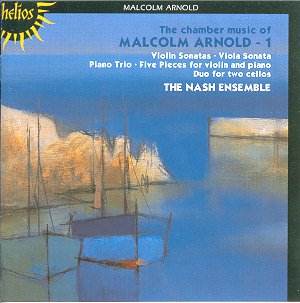Malcolm ARNOLD
Chamber Music Volume 1
Violin Sonatas 1 & 2, Viola Sonata, Duo for two 'cellos,
Five Pieces for violin and piano, Piano Trio
 The Nash Ensemble
The Nash Ensemble
 Hyperion Helios CDH
55071 [56.23]
Hyperion Helios CDH
55071 [56.23]
Crotchet
£5.99 Amazon UK Amazon
US

This first volume in Hyperion's complete survey of Malcolm Arnold's Chamber
Music now reappears at medium price (as do Volumes
2 &
3) and is almost self-recommending. It
was originally taped in 1984 during a decade which saw the Nash Ensemble
engaged in the recording studio (for a number of British independent labels)
at a greater regularity than any other similar chamber group, before or since.
By this date the techniques of digital recording were thoroughly understood
by the best sound engineers, and this seventeen-year-old recording sounds
as good as new. It is a typical example of the work of Mike Clements (originally
known under the pseudonym of Mr. Bear in his early Classics for Pleasure
days) - open sounding, truthful to the instrumental timbres and well balanced
within a natural acoustic.
For many, the name of Malcolm Arnold will conjure up memories of instantly
attractive and tuneful miniatures, such as the English and Scottish dances,
or examples of fine yet subtle orchestration as found in the symphonies,
particularly the luscious Fifth with its Mahlerian overtones. For others
Arnold will simply be known as one of Britain's finest composers of film
music.
But, of course, there was always a great deal more. The catalogue of Malcolm
Arnold's works is a fascinating document, not the least for showing how extremely
prolific he has been throughout his composing career. There are works for
almost every conceivable combination of instruments, particularly in the
chamber music field. But small scale forces generally did not persuade the
composer to make small scale or light utterances; indeed the very challenge
of writing music for a handful of players seems, paradoxically, to have pushed
Arnold into composing some of his most thoughtful and challenging music.
This CD features his music for stringed instruments accompanied, in the main,
by the piano. Each work is beautifully crafted and the pieces composed in
the ten post-war years, in particular, are some of the best examples of the
grittier side of Arnold the composer. Only the third movement of the 1947
Violin Sonata No. 1 - pleasingly played by Marcia Crayford (violin) and Ian
Brown (piano) - displays any of Arnold's famously wicked sense of humour.
The first movement sounds very 'modern' with the basic tonality often called
into question by both the protagonists. Yet tonal Arnold's music always remains,
much to its benefit. The second movement with its almost continuous fixed
rhythm two-part 'chugging' from the piano, accompanied by a tranquil legato
melody from the violin is notable for its short but dramatically dissonant
passage which briefly disturbs the seemingly innocent flow.
The second Violin Sonata (1953) is cyclic in form and within its short seven
minutes Arnold develops his material with consummate skill. It could be that
this was the first piece to be recorded (it happens to appear first on the
disc) as one senses a slight tentativeness from both players which does not
re-occur elsewhere.
Roger Chase is one of Britain's finest violists and the Viola Sonata (also
from 1947) is a true highlight on this CD. The first movement is clearly
influenced by Bartok - one wonders if his unfinished concerto of just two
(and more) years earlier could have been known to Arnold - with sliding pizzicati
and unusual harmonic effects. We are back to Britain with a bump in the second
movement which, although occasionally meandering, is a hauntingly beautiful
pastoral. The finale Presto feroce fizzes.
The Five Pieces were written for Menuhin to use as encores during a 1965
US tour. What the Americans made of these slight but thoughtful pieces one
cannot guess, but they were surely a better alternative to the usual warhorses.
The Duo for two 'cellos was specifically composed to cover a mere two pages
(only) of a textbook for the sleeve note writer Hugo Cole. The challenge
produced in Arnold a most subtle little work which The Nash Ensemble's much
missed 'cellist Christopher van Kampen with Moray Welsh (brought in for the
occasion) play to perfection.
Surprisingly, perhaps, the Piano Trio (1956) is not the longest work on this
CD (here the honours go to the Violin Sonata No.1 and the Viola Sonata) but
it deserves a prime billing. The first movement portrays the string players
as protagonists, but the piano's comments increasingly dominate the musical
structure as well as the interest of the listener. The canonic second movement,
in just five minutes, truly excites the emotions and the finale - a set of
variations - achieves that well-known Arnoldian trick of never quite letting
the cat out of the bag for the listener until the very end. Satisfaction
guaranteed.
If you can, collect all three CDs in this very well conceived series.
Reviewer
Simon Foster
See reviews of Volume 2 and
Volume 3

